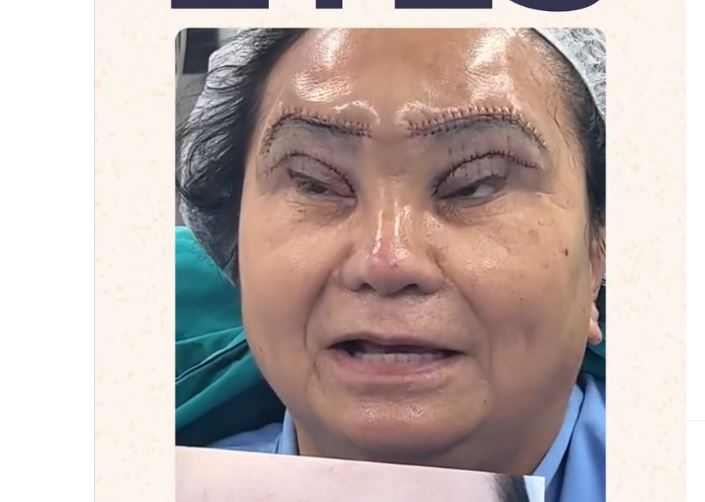In addition to its striking results, Black Swan eye surgery has recently attracted a lot of public attention due to the reactions it has elicited from seasoned surgeons. The nickname comes from the fact that this dual procedure, which combines an upper blepharoplasty with a direct brow lift, promises to produce a lifted, wide-eyed appearance that mimics the dramatic poise of a ballet dancer. However, some people are finding that the results are much less graceful.
One instance that Dr. Gary Linkov documented on his well-known YouTube channel has turned into a particularly potent talking point. Dr. Linkov is well-known for his composed and incredibly clear explanations, so his shocked reaction to the patient’s post-surgery photo—in which he audibly exclaims, “Oh God”—spoke volumes. His breakdown showed that he had undergone eyelid reduction and a direct brow lift procedure, which resulted in an extremely dramatic appearance. The woman’s eyelids were noticeably stretched, her eyebrows were drawn high with visible stitching, and the overall effect was eerie rather than elegant.
Black Swan Eye Surgery Summary
| Name of Procedure | Black Swan Eye Surgery |
|---|---|
| Type of Surgery | Cosmetic (Blepharoplasty + Brow Lift) |
| Focus Area | Upper Eyelids, Eyebrows |
| Primary Goal | Create lifted, elongated eye shape |
| Typical Techniques Used | Upper Blepharoplasty, Direct Brow Lift |
| Key Benefits | More defined eyes, youthful look |
| Major Risks | Overcorrection, unnatural results, scarring |
| Known Complications | Stitched brows, visible incisions, asymmetry |
| Prominent Discussion | Reviewed by Dr. Gary Linkov on YouTube |
| Recovery Timeline | 7–14 days typically, may vary |
The public’s growing concern over the pursuit of extreme cosmetic procedures was remarkably similar to this sharp response, especially from an experienced facial plastic surgeon. Although the procedure itself is not dangerous, the tendency toward overcorrection, which is fueled by transient beauty that has gained popularity online, can leave behind permanent features that are unbalanced and unsubtle.
Cosmetic procedures have become remarkably accessible in recent years. A new demographic has been made available by non-invasive treatments and the widespread use of injectables like Botox. However, there is an urgent need for education along with that accessibility. Although technically feasible and frequently well-intentioned, Black Swan eye surgery walks a fine line between distortion and enhancement. It is intended to lift the brow and remove sagging skin from the eyelids, but if done too harshly, it leaves a frozen, startled appearance that is hard to get back.
Given how expressive and structurally delicate the area around the eyes is, this is especially dangerous. The impact on an individual’s overall identity is particularly direct, the tissue is thin, and the healing process is intricate. Perceived emotion, age, and energy can all drastically change with even minor changes to the upper face. Some people, like the patient in Dr. Linkov’s video, may find the change so abrupt that it causes unanticipated social reactions.
Discussions about this trend have started to circulate recently on social media sites like Instagram and TikTok, where highly filtered beauty standards have already skewed public perceptions. Popularized by digital filters and beauty influencers, the sharp, elongated eye look is now being surgically replicated, frequently without full awareness of the risks. It is a component of a larger cosmetic evolution in which software, rather than nature or ancestry, shapes ideals of beauty.
Black Swan eye surgery appears to be a quick fix for medium-income patients looking for more long-term fixes. Those who are influenced by stylized digital faces, however, might not be aware of how little margin for error these processes allow. Individual anatomy, skin elasticity, and the body’s healing process can all have a big impact on the results. In consultation rooms where “before-and-after” pictures are the main focus, these factors are easy to overlook.
Some clinics promote these procedures as quick, life-changing fixes by utilizing viral content. However, industry insiders are voicing concerns. Surgeons at respectable clinics like Eagle Aesthetics stress the importance of reasonable objectives and a carefully considered medical strategy. Both physically and emotionally, the stakes are high. If expectations are not carefully managed, patients who come to surgery hoping to feel empowered may leave with regrets.
Many people used cosmetic procedures as a way to rejuvenate themselves during the pandemic. They were able to recuperate out of the spotlight by working remotely, and the emphasis on online appearances heightened interest in facial enhancements. Some of these procedures, such as Black Swan eye surgery, have shown the drawbacks of chasing too much too soon, but others have been remarkably successful in boosting confidence.
The current trend in beauty culture is a move away from enhancements that look natural and toward drastic changes. Lip fillers and jawline contouring followed the same path. Excitement was followed by overcorrection and then a gradual return to moderation. It looks like Black Swan eye surgery is about to enter that transitional stage where professional prudence meets public enthusiasm.
His emotional response was unusual and telling, according to comments made by viewers of Dr. Linkov’s video. One person stated, “You never want your surgeon to say ‘Oh God’ while examining your case.” Another observed how his worry overcame his normally calm demeanor, demonstrating the surprisingly drastic outcomes. These public responses, which are characterized by anxiety and introspection, are arguably the best examples of how beauty trends ought to be viewed: cautiously but curiously.

